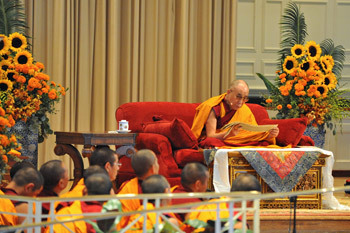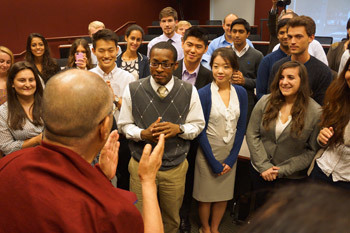Atlanta, Georgia, USA, 10 October 2013 - Acceding to a request from Drepung Loseling Monastery in Atlanta, after arriving at the Glenn Memorial Auditorium of Emory University this morning, His Holiness the Dalai Lama lost no time before beginning his explanation of Panchen Lobsang Chogyen’s Root Stanzas on Mahamudra. He made clear that he would not follow the traditional procedure that requires preliminary prayers and repeated explanations, but would give a straightforward account of the verses.
He led the 1200 people present in reciting the traditional verse which in the first two lines concerns taking refuge in the Three Jewels and in the second two lines concerns developing the awakening mind of bodhichitta. Both sections refer to ‘I’, so for them to make sense we have to have some sense of self.
“Generally,” His Holiness said, “we think of the self as the controller of our body and mind. But if we examine things closely no self distinct from the body and mind can be found. This leads to the understanding that the self is a kind of label; it’s like an illusion. It seems solid and real, but we come to understand that it does not have a separate reality.”
He explained that the Buddha talked about various systems like the Hearer’s Vehicle and the Bodhisattva Vehicle. In this context, in Tibet there was talk of ten divine norms and sixteen human norms. The ten consist of the practice of morality leading to a favourable rebirth, whereas the sixteen are more concerned with basic human civility. The ten norms relate to religious practice and are common to all religious traditions, with the possible exception of ‘wrong view’.
The primary aspiration of the Hearer and Solitary Realizer Vehicles is to achieve liberation and they focus on the Four Noble Truths and training such as the 37 aspects of the path to enlightenment and the twelve links of dependent arising. But for the Bodhisattva Vehicle the goal is not your own liberation, but the alleviation of the suffering of all sentient beings. It focuses on the Three Higher Trainings and the achievement of Buddhahood. Within the practice of the Vajra Vehicle on the one hand Dzogchen speaks of nine yanas, while tantras of the later translation schools speak of the four classes of tantra. These can be viewed as correlating with each other. In all of these practices the emphasis is on understanding the nature of the mind.
“They have different approaches, but they converge on the same point. I am not claiming to be an experienced yogi,” His Holiness declared, “but after receiving much teaching I conclude that all these teachings converge on the same point. About this Je Tsongkhapa, who took a broad rather than a partisan view of his studies, concurs.

|
His Holiness the Dalai Lama during his teachings at at Emory University in Atlanta, Georgia on October 10, 2013.
Photo/Sonam Zoksang
|
“I received the transmission of the Root Stanzas on Mahamudra and its commentary from Kyabje Trijang Rinpoche and of the Root Stanzas alone from Kyabje Ling Rinpoche. Historically, Tashi Lhunpo was the centre of the Wensa ear-whispered lineage to which this practice belongs.”
During his reading of the stanzas of the text, His Holiness remarked that because the mind is in a sense the creator of our universe, it is important to choose the mind as the object of our meditation on emptiness because it has such impact. With regard to understanding emptiness the two key sources are Nagarjuna’s ‘Fundamental Treatise on Wisdom’ and the Perfection of Wisdom texts, to which the ‘Heart Sutra’ belongs.
From the ‘Fundamental Treatise on Wisdom’ chapter 24 is important, and within that two verses are crucial:
18. Whatever is dependently co-arisen
That is explained to be emptiness.
That, being a dependent designation,
Is itself the middle way.
19. Something that is not dependently arisen,
Such a thing does not exist.
Therefore a non-empty thing
Does not exist.
Similarly important are the following lines from the ‘Heart Sutra’:
Form is empty; emptiness is form.
Emptiness is not other than form;
Form is also not other than emptiness.
Likewise, feelings, discriminations, compositional factors
and consciousness are empty.
His Holiness recommended thinking about these verses every day, which will in due course yield a glimpse, a taste of emptiness.
When he reached the end of the Stanzas he said:
“This teaching of Mahamudra is complete; it has been difficult to explain it in greater detail because we have been short of time. However, this is about how we can transform our minds. Using our intelligence we can transform our emotions. Think about these things as regularly as you eat food. You don’t say ‘I ate well yesterday, so I don’t need to eat today.’ So don’t think, ‘I thought about this yesterday, I can leave it today.’
“This university made me an honorary professor; today the professor’s duty has been done.”

|
His Holiness the Dalai Lama visiting a Business Studies classroom and interacting directly with the students on the topic of Secular Ethics during his visit to Emory University in Atlanta, Georgia on October 10, 2013. Photo/Jeremy Russell/OHHDL
|
His Holiness was invited to lunch at Emory President James Wagner’s Residence. Afterwards, he gave a short interview to a New York Times writer who is preparing an article on the Emory-Tibet Science Initiative. He told her:
“I’m a student of Buddhism, a tradition that has a great deal of knowledge about the inner world of the mind. Modern science knows a great deal about the external world. When these two come together, we have the potential to reach a more comprehensive explanation of reality.”
In the afternoon he joined two classes in the University. The first was a Business studies class in which he told the students:
“I know business and money are important, but how to make money I have no idea. However, for any human profession to be constructive requires a good motivation. It needs transparency that leads to trust, which is essential for co-operation.”
He also remarked that competition can be thought of as of two types. One which aims to obstruct and stifle rivals tends to be negative. The other that creates an energy of benefit to all participants is helpful.
The second class he visited consisted of students who had studied his books on secular ethics. When a student asked his advice for someone with spiritual inclinations but little interest in established religion, he replied:

|
His Holiness talking to students during his visit to their classroom at Emory University in Atlanta, Georgia on October 10, 2013. Photo/Jeremy Russell/OHHDL
|
“This is exactly the spirit of secular ethics. As you know, it is not something separate from our spiritual traditions. But if you want to take it further, you could add some meditation, both analytical meditation which is similar to the discussions you have in this class and single-pointed meditation that serves to sharpen your awareness. Every morning you could do some yoga and follow it with single-pointed meditation. That might be productive.”
At the end His Holiness was asked to speak about the Pope in relation to secular ethics. He responded that John Paul II was a wonderful man, a great spiritual leader, who he had asked whether ethics should necessarily be grounded in religion. The Pope remained silent, but one of his Cardinals said, “Yes.” Pope Benedict on the other hand said, “.... faith and reason must go together”. With regard to Pope Francis, His Holiness said he seems very realistic and practical, but he has not yet met him; he hopes to do so in the coming year.
This brought an end to His Holiness’s engagements and meetings in Atlanta. Tomorrow he will travel on to Mexico where he will be staying for six days.
















